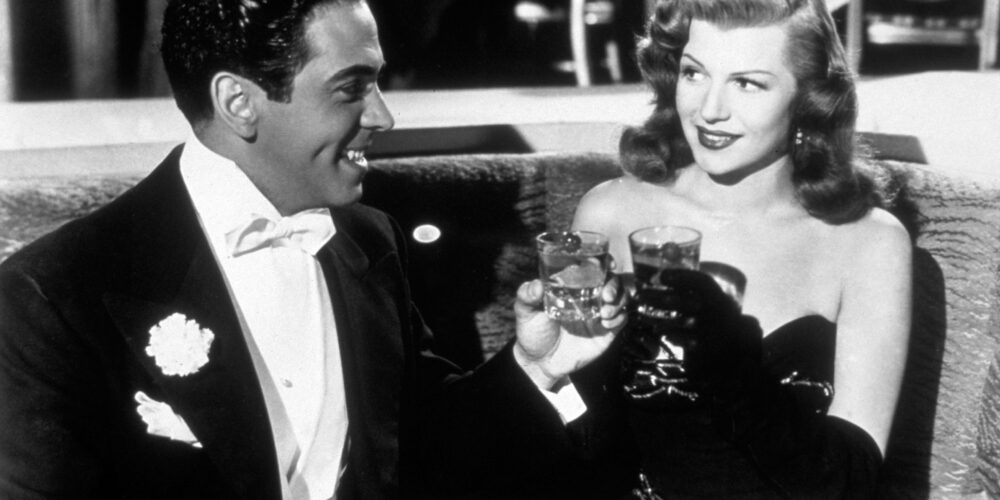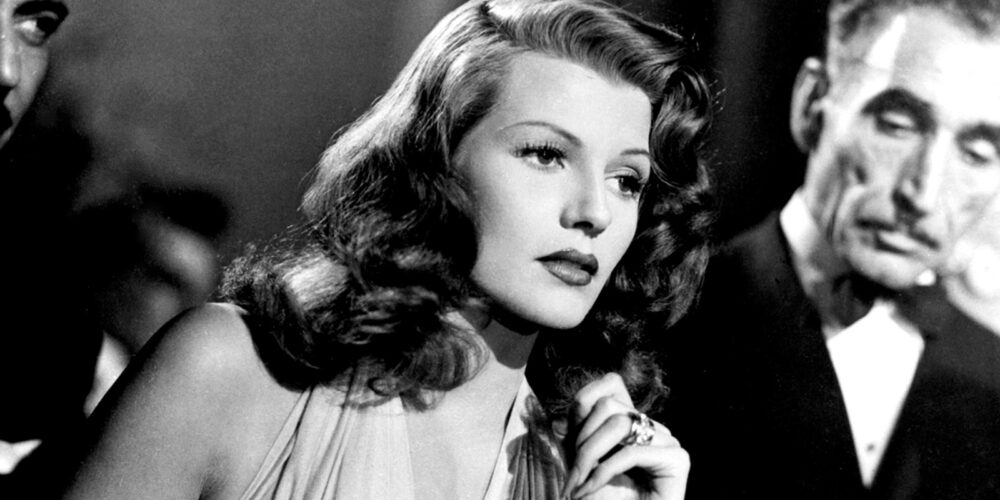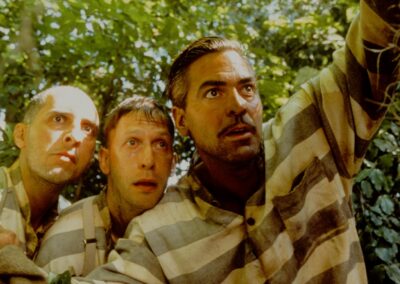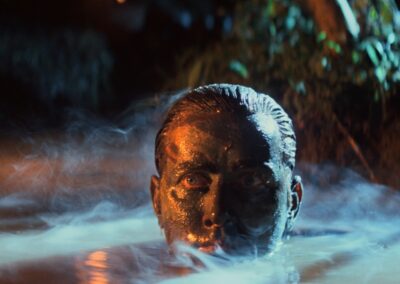Charles Vidor’s 1946 Gilda, which is screening in a new 75th anniversary print at the UPP this month, with its eponymous femme fatale central character; brooding atmosphere (courtesy of Carl Dreyer’s cinematographer Rudolph Matte) and dark thematic concerns is (in spite of its much heralded music and dance numbers) widely considered to be one of the first Hollywood film noirs – those paranoid, cold war urban crime dramas like Double Indemnity, The Killers and Laura in which women could not be trusted and lured hapless fools to certain death in dark cities, oozing with vice, corruption and betrayal.
It stars the “love goddess” Rita Hayworth and Canadian “beefcake” Glenn Ford, who is one of Hollywood’s slightly overlooked “everyman” actors. Also in this group you might include the more celebrated James (“Jimmy”) Stewart and Gary Cooper.
These were male stars (and it’s hard to believe quite how big a star Glenn Ford once was) whose on-screen personas appeared to reflect qualities which both male and female viewers would find “plausible and realistic.” They were actors you could relate to – grown up versions of the boy next door. They were handsome but not too good looking; they tended to project very similar versions of themselves into most of the roles they played and they were not “threatening” (rarely, if ever, playing the villain). Today, you could argue that Tom Hanks takes on very similar roles.
These male “everymen” were like kindly uncles who, you imagined, were just as nice off screen as they were on it (indeed, Stewart is renowned for being an all round “good guy,” with many of his colleagues declaring that he was very similar to the characters he portrayed on screen – which is why he is so fascinating in the films he made with Hitchcock [Rear Window and Vertigo, particularly] and the westerns he shot with Anthony Mann [The Naked Spur] which were films which “played with” that persona and suggested that beneath the smooth surface, something dark and tortured might be lurking).
They could appear in a wide variety of genres; were often adept at comedy and light-hearted roles and between them made an awful lot of movies (Ford’s filmography runs to nearly 100 movies).

Whilst he was enormously popular in the 1950s and 60s (5th most popular star of 1956; 6th most popular in 1959 and 12th most popular in 1960 – according to the Quigley Poll of Film Exhibitors) unlike Stewart and Cooper, few films Ford starred in have entered the canon. Alongside Gilda, Fritz Lang’s 1959 noir The Big Heat (which also starred the beautiful Gloria Grahame and hard as nails Lee Marvin); Rock’n’ Roll teen drama The Blackboard Jungle and western 3.10 to Yuma are possibly his best known films. He ended his career as Superman’s father in the 1978 Richard Donner movie and, like many other former Hollywood greats, was “reduced” to trashy horror films in the early 80s, when he appeared in J Lee Thompson’s risible Happy Birthday to Me in 1981 (British director Thompson, lest we forget, had once shown much promise in the 1950s and 60s – he was responsible for, amongst others, Ice Cold in Alex (1958), The Guns of Navarone (1961) and Cape Fear (1962) but ended up in the 1970s and 80s becoming a “hack for hire” with films like the ludicrous WW2 drama The Passage (1979) and a large number of “straight to video” Charles Bronson thrillers, including his final film Kinjite: Forbidden Subjects (1989) besmirching what once was a solid CV).
Off screen (and on, occasionally) Ford, with his slick backed DA hairstyle and chiselled jaw line, was, however, something of a lothario, having relationships and affairs (according to his son, in his 2011 biography Glenn Ford – A Life) with no less than 146 actresses. These included, amongst others, Gloria Grahame, Gene Tierney, Barbara Stanwyk, Marilyn Monroe, Joan Crawford, Judy Garland, Angie Dickinson, Debbie Reynolds, Brigitte Bardot, Hope Lange and also with Gilda herself – Rita Hayworth (it resulted in the ending of her second marriage – to Orson Welles but lasted on and off for over 40 years). Ford was also four times married and subsequently divorced.
These are not speculations – Ford, apparently, recorded his phone conversations with lovers and friends throughout his career and was a compulsive diarist. He may, of course, have also been one of Hollywood’s biggest braggers, but, according to stripper and actress Liz Renay, with whom he was also “romantically involved,” Ford was also one of her “top five” best lovers.
Hayworth had a similar but far more tragic string of relationships – often with men who she described as having “mean personalities.”
Hayworth, who along with Betty Grable, became one of the most popular “Pin Ups” of the Second World War and whose image was reproduced on the atomic bomb tested on the Bikini Atoll in 1946 (she was, after all, a world renowned “bombshell” by this point – albeit a red-headed one) was probably sexually abused by her father, with whom she danced professionally from an early age, under her original name (and with “exotic” black hair) Margarita Cansino. She went on to be an outspoken critic of the studio system – especially her treatment under contract by Harry Cohen at Columbia Pictures and she married Edward Judson early in her career – a man twice her age, who helped launch her as an actress but also treated her cruelly, financially taking advantage of her as she began to achieve success.

Her second marriage (to Orson Welles in 1943) was always on the rocks due to his egotism and her drinking and bouts of depression (the affair with Ford, whilst making Gilda contributed to its breakdown). As the marriage was disintegrating, in 1947 the couple made another celebrated film noir The Lady from Shanghai, Welles’ decision to get his wife to cut her hair and go platinum blonde, possibly adding to that film’s box office failure. It was certainly despised by the Columbia, who demanded reshoots and brutally re-edited the finished movie , burning the negatives of over an hour’s worth of footage, removed from Welles’ original cut.
As well as conducting affairs with her co-stars (most notably Victor Mature) Hayworth went on to marry “playboy” Prince Aly Khan, son of the Shia Islam leader Aga Khan III. This marriage ended up in a public slanging match and much publicised divorce in 1953 during which their daughter, Princess Yasmin Aga Khan, was something of a puppet (Hayworth wanting her raised as a Christian, Aly Khan insisting she should be raised in the Islamist faith). Eventually “extreme cruelty, entirely mental in nature” was used as the grounds for divorce.
Her penultimate marriage, to unsuccessful crooner Dick Haymes, ended in a violent altercation in the Cocoanut Grove nightclub in LA and further financial chaos, caused in part by Haynes’ debt and film producer James Hill, her fifth and final husband, whilst getting her “comeback” parts in several worthwhile projects (most notably Delbert Mann’s film version of the Terrence Rattigan play Separate Tables in 1958) also turned out to be abusive when she tried (unsuccessfully) to retire from acting and he effectively “forced her” to continue. This marriage lasted until 1961, after which she remained single, although it’s worth noting that, in 1960, Ford moved next door to her house in Beverley Hills and remained her friend (and occasional lover) until the 1980s, when it was announced she was suffering from Alzheimer’s disease, which was attributed as the main cause of her death, aged 68, in 1987.
The man who could have had (and probably did have) almost any woman in Hollywood stood by Hayworth in her dotage. There’s something terribly Romantic about that.
Ford lived on until 2006, after retiring from acting in 1991, his fourth and final marriage to Jeanne Baus, ending after one year, in 1994. He spent his last years alone.
One wonders whether he dreamed of Hayworth up until the end? You’d like to think so.
We are screening the 4K restoration of Gilda on Sunday 10th, Monday 11th, and Thursday 14th November. Join us on Sunday 10th at 3pm for a screening plus an introduction by Dr Andrew C Webber (author of this blog piece). Click here for more information and to book tickets.
Dr Andrew C Webber is a Film teacher and examiner with over 38 years’ experience. He currently contributes to both the Cinema of the 70s and 80s magazines (available on Amazon); cassette gazette fanzine (available from cassette pirate on e-bay) and the Low Noise music podcast available on Spotify and Apple podcasts.


